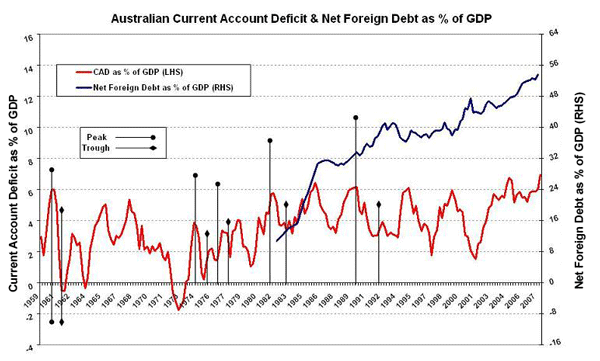Amen to that, and if wage claims and settlements continue to escalate - and there are many pressures from the mining boom as well as degraded public services - it will trouble inflation fighters in the Reserve Bank and elsewhere.
The current account deficit is another powerful indicator of pressure on demand in an economy. Technically, it measures the excess of aggregate demand over domestic supply for goods and services. Australia is a growing economy and as such this excess is acceptable, up to a point.
The point at which markets (or policy makers) cry "enough is enough" is impossible to predict but our graph of almost 50 years of history is suggestive.
Advertisement
The red line on the graph shows the CAD as a ratio to GDP. The blue line shows net foreign liabilities, also as a ratio to GDP.

The vertical lines show the timing of peaks and troughs in the business cycles - as measured by the Melbourne Institute based on the pioneering work of Dr Ernst Boehm many years ago.
There is a clear message - a CAD of about 6 per cent of GDP signals danger for the economy.
Every cyclical downturn - except those in the troubled 1970s - has been accompanied by a CAD to GDP ratio of 6 per cent.
Let us briefly discuss the episodes involved. The 1950s experienced a long boom with both inflation and the CAD building gradually. In 1960 the Menzies government hit the brakes and produced a short, sharp recession that fixed both for a decade.
Advertisement
The 1970s CAD was lower as much of the initial cyclical impetus was from the global commodities boom. Inflation was imported in part through the effects of a strong CAD but when the Whitlam government added to domestic demand, inflation soared to peak around 16 per cent.
During the 1970s the CAD was building, leading finally to another 6 per cent cyclical peak in 1981-82. During the resulting downturn the Reserve Bank began to publish estimates of Australia's international debt.
The next 6 per cent peak in the CAD was in the mid-1980s, when a vigilant central bank warned Treasurer Paul Keating of the expanding CAD and associated blowout of Australia's international debt. Keating declared the nation was in danger of becoming a banana republic and persuaded the cabinet to cut government spending. Political leaders in turn persuaded the ACTU to cop a necessary cut in real wages. Keating was persuaded to authorise hikes in interest rates.
First published in The Australian on April 1, 2008.
Discuss in our Forums
See what other readers are saying about this article!
Click here to read & post comments.
3 posts so far.